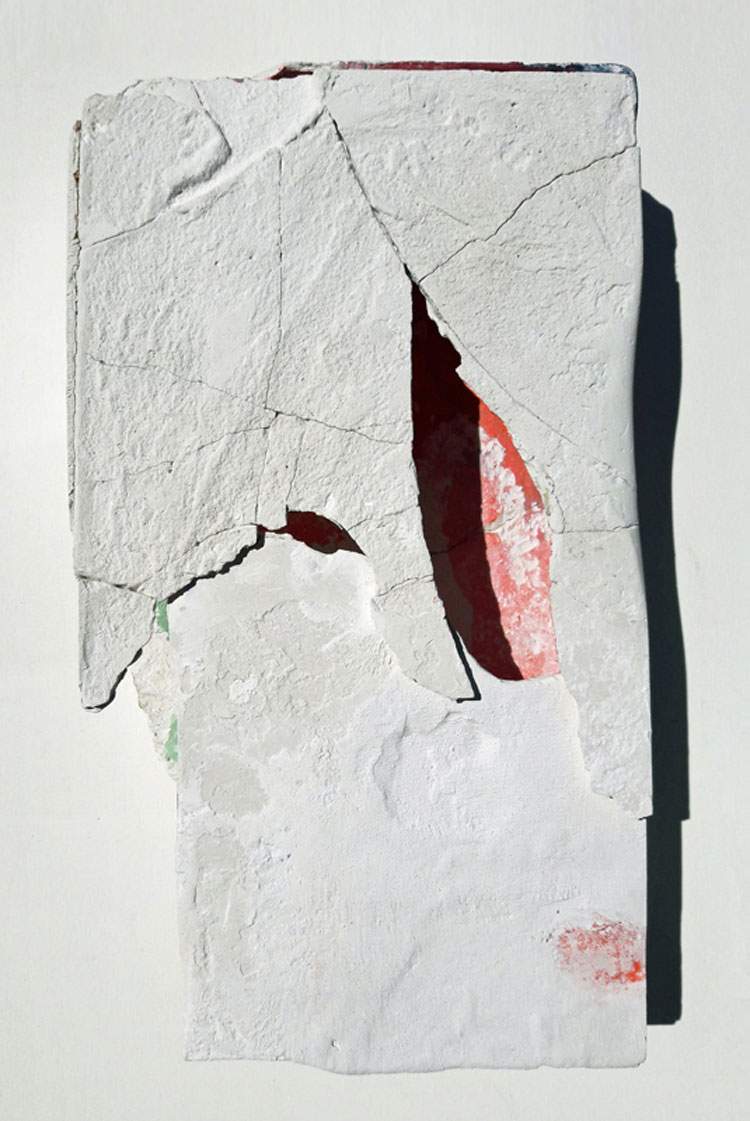From September 9, 2020 to February 14, 2021, the Museo del Novecento in Milan is hosting the exhibition Franco Guerzoni. The subtracted image, curated by Martina Corgnati.
Works made by Franco Guerzoni (Modena, 1948) in the last decade centered on the...wall will be on display. Old and peeling walls, with plaster and bulges, cracks, scratches, outcroppings and molds are protagonists first of all in the early days in photographic shots used as support for his work; later they are re-proposed on canvas: wall-palimpsests with evocative outcroppings on which the artist’s entire personal archaeology has been articulated.
The images will be placed in dialogue with works from the early 1970s born from his collaboration with photographer friends Luigi Ghirri and Franco Vaccari.
The exhibition will continue with Franco Guerzoni’s latest research entitled Intravedere: small rooms of chalky material that float like open books, but whose image is hidden, “subtracted” from the viewer’s gaze.
These works will be accompanied by the work-books: from the 1970 Book of Dreams to the 2014 Ideal Museum. Books to look at but above all to “act”, which contain the reflections of the many poets, critics and literati, friends who have always followed the artist’s path.
In the exhibition,a space is also reserved for photographic sequences, often unpublished, that narrate projects and aspirations dating back to his restless origins that the artist calls Unsolved.
Finally, a video, made especially for the occasion by Eva Marisaldi and Enrico Serotti, will narrate in stages and with irony, affection and rigor, Guerzoni’s work as a whole, including the part that will not be able to be present in the exhibition.
“With an expression of the curator Martina Corgnati, which I make my own,” said Guerzoni himself, “the exhibition will have to be ”intimate" as intimate is the space that receives it at the Museo del Novecento: the great hall of the Lanterna and the space of the Archives. It will not pursue the ambition to narrate a biography, but rather to accept the fragmentary nature of some seasons of research that here seek to meet in a significant temporal distance. Works from the early 1970s will be exhibited that like flying nymphs seek contact with current research and constitute, I believe, still its driving force, a memory never faded in its past. Thus the small plaster aediculae bearing a picture of gutted houses entitled Frescoes still seem to be the suggestion that whispers to the current, large-scale paintings, the fascination I have with opaque painting, the forgotten wall and the fact of looking after its fragments: all ideas that accompany me to the stratifications of the large panels of Archaeologies without restoration or the Powdered Landscapes that are its most recent outcomes. The occasion will also make it possible to present small unpublished works, miniature rooms to be perceived through a slanted gaze that forces the viewer in a twisting movement of the head to search for the hidden enigma; Intravedere is the title. The large glass cases that circumscribe the archive allow the display of that Ideal Museum consisting of colored plaster casts that court the bas-relief, real walls to leaf through, an archaeology of the everyday in which even the small fragment of yesterday dialogues with forms of the remote. A shy and smiling space appears to be the one dedicated to the exhibition of papers, photos and documents that take charge of narrating the origin of the work between euphorias and defeats: they are those Unresolved that wish to be looked at with the indulgence of those who want to witness the creative theater germinated among the many influences and contaminations assimilated from the late 1960s to the early 1970s, that search for the “new” at all costs between the fires of the avant-garde and political antagonism. Eluding an anthology proper that would have forced me to join in a straight path my work, I preferred the labyrinth offered by its thousand fragments. It is also pleasing to me to review in the cold light of the large light tables in the Archives all my production of work-books, accompanied by texts by friends writers, critics and art historians. These particular achievements are certainly the most thoughtful part of my work. Action books edited in a few copies accompanied by the affectionate words of Sebastiano Vassalli, Adriano Spatola, Emilio Mattioli, Paolo Fossati, Henry Martin just to name a few. The images that appear in the volumes are often photographic collaborations with Luigi Ghirri and Franco Vaccari. In fact, if the exhibition of the paintings eschewed the anthological idea, the work-books instead represent a true anthology."
Image: Franco Guerzoni, Intravedere (2018; pigments, scagliola on plaster box, 31 x 18 x 7 cm). Courtesy Monitor, Rome, Lisbon, Pereto.
 |
| Franco Guerzoni and his stolen images protagonist at the Museo del Novecento |
Warning: the translation into English of the original Italian article was created using automatic tools. We undertake to review all articles, but we do not guarantee the total absence of inaccuracies in the translation due to the program. You can find the original by clicking on the ITA button. If you find any mistake,please contact us.